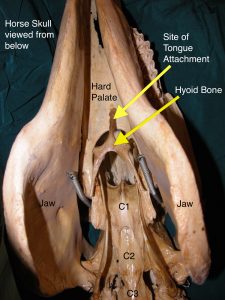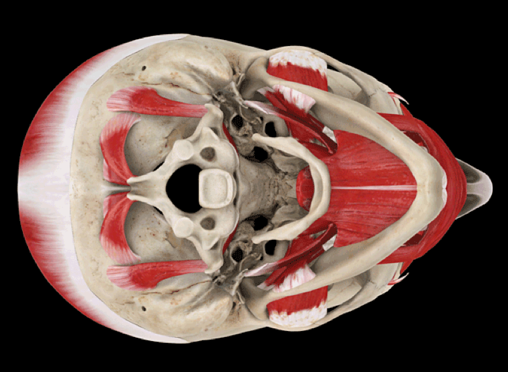
Do you know what your tongue is doing while you ride? Is it relaxed or tense? Do you move it around or brace it against the roof of your mouth or cheek? Does your horse play with the bit, pull his tongue back or stick it out to the side? Your horse may be mirroring your own tongue tension! Observing your tongue and relaxing this very powerful muscle can solve alleviate tension in your body and resolve some of the habits your horse has with his bit.
Next time you ride notice where the tip of your tongue is placed within your mouth. Is it pressed up against your palate (roof) or your upper front teeth? Do you pull your tongue back or push it forward? Does it fill your oral cavity (the space inside your mouth between your teeth, palate and jaw)? Or is there a lot of open space indicating muscle tension? Are your mouth and lips moist or dry when you finish riding? As with your horse, a dry mouth indicates too much mouth tension!
While it is often said that the tongue is the strongest muscle in the body, this is not true. However that does not negate the tongue’s importance in a number of roles! The tongue is skeletal muscle, meaning it can be willingly controlled. It is vitally important for the digestive process, guiding and molding food. As a sensory organ your tongue has the ability to sense texture, taste, heat, cold and pain, and it is vitally involved with speech.

The tongue in both horses and humans consists of several individual muscles secured to the surrounding the floor of the oral cavity (frenum) and anchored at the back to the hyoid bone, a horseshoe shaped bone located at the front midline of the neck, below the jaw, above the thyroid and in front of the neck. Through the hyoid, the tongue is connected to the skull, jaw, 1st and 2nd cervical vertebrae, and perhaps, most importantly, to the sternum and shoulders. Because of this, there is a direct connection from the tongue to the back and from the back to the tongue. Back pain can be expressed in tongue tension, and teeth problems can cause a tight back, which is why a relaxed tongue is so important in both horses and riders!
To feel this connection, sit quietly and purposefully tense your tongue either by stiffening it, by pulling it back, or by pushing the tip against the roof of your mouth or against the side of your teeth. Then relax and feel what area of your throat, jaw, neck and back soften. Allow the tip of your tongue to rest just behind your lower front teeth. Notice how the tongue fills your entire mouth. When mounted, during your warm-up walk, tense and relax your tongue while observing any changes in your horse. Again rest the tip of your tongue behind your lower front teeth.
Depending on how sensitive you and your horse are you can ride transitions using your tongue. For half-halts and down transitions think of gently sucking on a lifesaver and then release. Feel this effect by placing one hand in the area under your jaw to sense how this draws the tongue root down slightly. Repeat this a few times while quietly walking on a loose rein, observing if your horse slows or stops. For up transitions imagine a dot of peanut butter on the roof of your mouth. Think of using the back of your tongue to push the peanut butter forward while keeping the tip of your tongue behind your lower front teeth. There will be a lifting sensation in the throat when you do this correctly. Since the tongue is attached to the hyoid bone, you may also feel a connection to your lower back and seat when using your tongue for up and down transitions!

Use this Murdoch Minute to alleviate tongue tension in you and your horse. When riding, experiment with using your tongue for subtle transitions and always remember to enjoy the ride!
By Wendy Murdoch
Copyright© 2014. All rights reserved.




